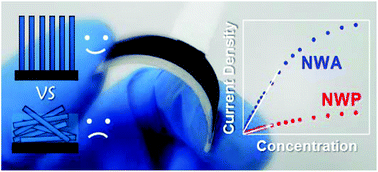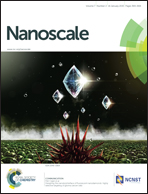Flexible 3D porous CuO nanowire arrays for enzymeless glucose sensing: in situ engineered versus ex situ piled†
Abstract
Convenient determination of glucose in a sensitive, reliable and cost-effective way has aroused sustained research passion, bringing along assiduous investigation of high-performance electroactive nanomaterials to build enzymeless sensors. In addition to the intrinsic electrocatalytic capability of the sensing materials, electrode architecture at the microscale is also crucial for fully enhancing the performance. In this work, free-standing porous CuO nanowire (NW) was taken as a model sensing material to illustrate this point, where an in situ formed 3D CuO nanowire array (NWA) and CuO nanowires pile (NWP) immobilized with polymer binder by conventional drop-casting technique were both studied for enzymeless glucose sensing. The NWA electrode exhibited greatly promoted electrochemistry characterized by decreased overpotential for electro-oxidation of glucose and over 5-fold higher sensitivity compared to the NWP counterpart, benefiting from the binder-free nanoarray structure. Besides, its sensing performance was also satisfying in terms of rapidness, selectivity and durability. Further, the CuO NWA was utilized to fabricate a flexible sensor which showed excellent performance stability against mechanical bending. Thanks to its favorable electrode architecture, the CuO NWA is believed to offer opportunities for building high-efficiency flexible electrochemical devices.

- This article is part of the themed collection: Editor’s Choice: Making sense of nanosensors and devices

 Please wait while we load your content...
Please wait while we load your content...